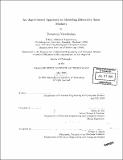| dc.contributor.advisor | Marija D. Ilić. | en_US |
| dc.contributor.author | Visudhiphan, Poonsaeng, 1973- | en_US |
| dc.contributor.other | Massachusetts Institute of Technology. Dept. of Electrical Engineering and Computer Science. | en_US |
| dc.date.accessioned | 2005-09-26T19:28:48Z | |
| dc.date.available | 2005-09-26T19:28:48Z | |
| dc.date.copyright | 2003 | en_US |
| dc.date.issued | 2003 | en_US |
| dc.identifier.uri | http://hdl.handle.net/1721.1/28270 | |
| dc.description | Thesis (Ph. D.)--Massachusetts Institute of Technology, Dept. of Electrical Engineering and Computer Science, 2003. | en_US |
| dc.description | Includes bibliographical references (p. 323-327). | en_US |
| dc.description.abstract | (cont.) The model could also be used to analyze market factors (such as new market rules) and their effects on market price dynamics and market participants' behaviors, as well as to identify the "best" response action of one participant against the opponents' actions. | en_US |
| dc.description.abstract | Current approaches used for modeling electricity spot markets are static oligopoly models that provide top-down analyses without considering dynamic interactions among market participants. This thesis presents an alternative model, an agent-based model, and uses it to analyze the markets under various conditions. These markets, in which the participants engage in sealed-bid auctions to sell and/or buy electricity regularly, are viewed as multiagent systems, or as repeated games, played by participants with incomplete information. To represent these market characteristics, the agent-based model is selected, consisting of several power-producing agents with non-uniform portfolios of generating units. These agents employ learning algorithms, including Auer et al. 's, softmax action selection, or Visudhiphan and IliC's model-based algorithms, in determining bid-supply functions from available information. The simulated outcomes from the agent-based model depend on the choice of non-uniform portfolios and on the learning algorithms that the agents employ. Model verifications against the actual markets are suggested; however, due to a lack of certain confidential information, numerical examples cannot be presented. Nevertheless, the model is used to analyze the effects of market structures and the effect of load-serving entities on the power-producer bidding behavior and market outcomes. This model could provide one of the main tools for regulators, system planners, and market participants to use scenario simulations to investigate market conditions that could lead to high electricity prices. | en_US |
| dc.description.statementofresponsibility | by Poonsaeng Visudhiphan. | en_US |
| dc.format.extent | 327 p. | en_US |
| dc.format.extent | 23559864 bytes | |
| dc.format.extent | 23605219 bytes | |
| dc.format.mimetype | application/pdf | |
| dc.format.mimetype | application/pdf | |
| dc.language.iso | en_US | |
| dc.publisher | Massachusetts Institute of Technology | en_US |
| dc.rights | M.I.T. theses are protected by copyright. They may be viewed from this source for any purpose, but reproduction or distribution in any format is prohibited without written permission. See provided URL for inquiries about permission. | en_US |
| dc.rights.uri | http://dspace.mit.edu/handle/1721.1/7582 | |
| dc.subject | Electrical Engineering and Computer Science. | en_US |
| dc.title | An agent-based approach to modeling electricity spot markets | en_US |
| dc.type | Thesis | en_US |
| dc.description.degree | Ph.D. | en_US |
| dc.contributor.department | Massachusetts Institute of Technology. Department of Electrical Engineering and Computer Science | |
| dc.identifier.oclc | 53246769 | en_US |
